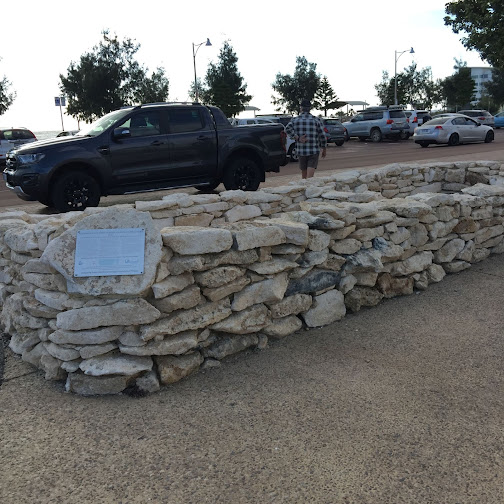Settled into Coronation Beach camp we headed into Geraldton, a 30 minute drive. Surveyed in 1850 and established as a convict depot in 1857. It served as a military post for the nearby Murchinson Goldfields. It was declared a town in 1871.The first stop was to see the Horizon Art Work at the Beresford forshore.
The two-tonne sculpture is a 1.5 metre sphere of clear 40mm acrylic filled with 1800 litres of water.
The light reflection inverts the surroundings to show 'the world upside down'.
Created by Lucy Humphrey as part of the Cottesloe Sculptures by the Sea, Horizon was damaged not long after we visited. The City of Geraldton is going to replace it.
Next stop was the Old Victoria Hospital located on Chapman Road in the heritage area. We got a park right in front of the old hospital, probably because it was closed - story of this trip. This was Geraldton's first hospital. Started as the convict depot in 1857, the Victoria Hospital was officially opened in 1864. The goal remained and the area was extended to include an isolation hospital, Old Men's Home, and Victoria (Geraldton) Hospital. The buildings are made of stone and were built according to the specifications of a design by Florence Nightingale, one of only two still remaining in Australia.
It is now known as the Bill Sewell Complex.
Next to the hospital is the old gaol, now a craft centre. It was established as a convict hiring depot in 1856 at a cost of 1,240 pounds. It was built by the first 20 convicts sent here from Fremantle. The gaol was closed in 1985 and was the second longest serving gaol in Western Australia. The first room upon entry is a brief history of the gaol and a rock collection.
When walking through the cell area it was so different to see some cells set up as craft rooms. Such a great use of space. It was so interesting walking into each cell and talking to the crafters. There are tours a few days a week.
The next stop was nearby, the Geraldton Museum. We were pleasantly surprised that many of Western Australia's museums are free, with donations accepted.
The big attraction at the Geraldton Museum for us was the wreck of the Bativia. We had listened to a podcast about it at home before we left. The Bativia story was interesting and also a horrific story. In 1629, the Batavia was shipwrecked on Morning Reef on the Abrolhos Islands and what followed was one of the most murderous mutinies in history.
Impressive was the huge replica of stone cargo that was to be used as a grand entrance portico façade in the city of Batavia. The museum also has a good short movie, timeline and artifacts about the wrecks of SydneyII and Korman in 1941.
Western Australian coast has many ship wrecks and they are all well documented.
Staying on the water front closer to the city centre, are egg sculptures, an interpretation of two paintings - The Emu in the Sky by Margaret Whitehouse (Wajarri) and The Seven Sisters and the Hunter by Barbara Merritt (Badimaya).
Indigenous astronomy saw different shapes in the night sky, emu, 7 sisters and a hunter.
Consisting of eight objects about 1.5 metres in length and covered in bright mosaic tiles, it is a celebration of the rich and cultural heritage of the first people.
Not far away is Batavia Park and a time line of history of the Geraldton area and its shipwrecks. The park is dedicated to the 200 innocent people lost in the tragedy.
A thin silver line has the engraved dates and a series of plaques that record the history.
The interpretive pathway is an interesting read.
Wiebbe Hayes 'Fort' is Australia's oldest European built structure. Located on West Wallabi Island, Abrolhos Islands. At Batavia Park there is a replica of the fort built in the original form using dry-stone walls that have been modified to make it safer. The original on West Wallabi Island is made of limestone from the reef platforms. The fort was built to defend Wiebbe and his soldiers from the Batavia mutineers.
Moore Point Lighthouse, located south of the town is the tallest metal lighthouse in Australia. Built in 1878, it is 34 metres tall and is an icon of the town.
Many intersections in the town have mini 'Moore Point Lighthouses' located on the intersections
We had lunch at Macca's (Jonnie's choice - I really don't like Macca's new recipes), and we stocked up at Coles before heading back to Coronation Beach. We decided to stay and extra day there as camping on the beach was just so relaxing. We caught up with Gary and Pat who we met in Derby, and prepared some meals to freeze.





























No comments:
Post a Comment